Birmingham features several specialised streets. For example, here, you can find the Jewellery Quarter and New Street, the main trading location. Learn more at birmingham-future.
Street by fields
The first mention of New Street dates back to 1296. Then it was called Novus Vicus. At that time, one part of New Street was built up with residential buildings, while another remained empty. There was nothing but the fields. In the middle of the 14th century, New Street was named le Newestret and it began to acquire the usual city outlines. Later, it was extended to Birmingham’s market, thus, connecting the city centre with the Bull Ring. In addition, New Street led to the house of the city founders, the de Birmingham family.
The street was significantly developed in the 18th and 19th centuries. Previously, the Town Hall appeared in the city as well. At that time, New Street was full of bright shop windows, hotels, theatres and buildings in the Elizabethan style. It also housed the Post Office.
Lost architectural objects
Birmingham and New Street were developing simultaneously. Sometimes, those changes erased some buildings from the street. They have disappeared forever from the city outline. You can find information about them only in the city’s archives.
The Guild of the Holy Cross was one of those lost buildings. Its architect was Charles Barry. Later, it was renamed the Free Grammar School. The building was rebuilt twice throughout the entire history of its existence. In 1939, the school was relocated to Edgbaston and its original building was demolished.

It wasn’t the only establishment that was moved to Edgbaston. The Hen and Chickens Inn, which was opened in 1798, was converted into the King Edward VI High School for Girls. After the school relocation, the building was demolished as well. Other buildings that housed the Colonnade Hotel were partially destroyed. That hotel was located in several buildings. Only a few of them have survived, although they have undergone some architectural changes.
The Theatre Royal was located on the street for 182 years. In 1956, it was closed and its building was demolished. The history of the Theatre Royal isn’t simple, as it survived two fires. Its distinctive architectural feature was a portico. It was added to the building in 1780 by architect Samuel Wyatt.
The building of the Royal Birmingham Society of Artists also featured a Greek Doric portico. The society moved to another street, near Saint Paul’s Square. Unfortunately, its original building was destroyed, although it could be a real architectural gem today.
Back then, many buildings were demolished in the pursuit of street outlook modernisation. Among them were Birmingham’s first department store, James Bisset’s museum and the Exchange.
New New Street
New Street has remained the central pedestrian street of the city in the 21st century. There is no permanent car traffic. New Street has developed a reputation as a major shopping zone connecting Corporation Street and High Street.
Many popular brands have opened their shops here. In addition, New Street houses many restaurants of various cuisines and small popular cafes.
Although New Street is considered the main shopping area, here, you can find various financial institutions such as Royal Bank of Scotland, Santander, NatWest and others.

New Street ends at Victoria Square. Every Christmas, the street houses a Frankfurt market. During that event, the street is full of wooden counters selling accessories and clothes in German style and, of course, food. The rest of the year, New Street hosts a farmer’s market twice a month.
Today, you can also find the Burlington Hotel on New Street. It is located in a grade II listed building. This architectural gem was designed by Edward Holmes. Its construction ended in 1869. Over time, the building underwent a number of renovations. In particular, the location acquired a glass roof over the area that used to be called Burlington Passage. The modern appearance of the Burlington Hotel is a vivid example of authenticity preservation in the course of modernisation processes. You can still see the lettering of the hotel’s former name, the Midland Hotel, on Stephenson Street.